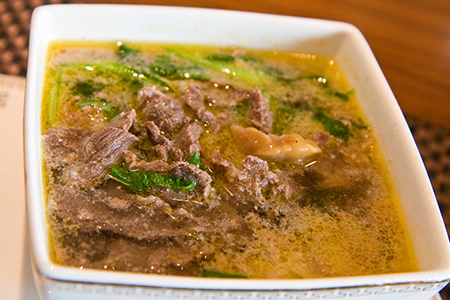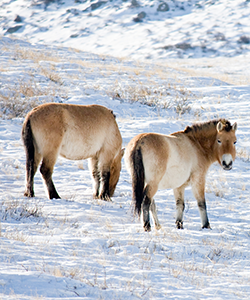A few weeks ago I ate horse — on purpose, while a scandal erupted in Europe regarding the presence of horse DNA in frozen meals and processed meat products. Traveling in Mongolia, my husband, Garrett, and I wanted to eat like locals. So we ponied up to a table in Ulaanbaatar, Mongolia’s capital, scanned the restaurant’s menu, and ordered horse meat soup.
Our first bite of the thin broth wasn’t bad — slightly salty, with a hint of pepper. Not four stars, but serviceable. We stirred, and up popped hunks of yellowish fat, goopier than Vaseline, meant to bestow some flavor. Then we found the meat.
Brownish-gray, it looked like what it was: dead flesh, and tasted like matted hair flavored with engine oil. Or so it seemed, since we’ve never eaten either hair or oil. Perhaps we were merely resenting how hard our jaws were working. We chewed. And chewed and chewed. And as we chewed we became conscious of the fact that this wasn’t the first time on this trip that we’d dined on equine.
We’d come to Mongolia to see horses, specifically the wild horses known as Przewalski’s horse, or Takhi, that roam the hills of Hustain Nuruu National Park, about 100 kilometers west of Ulaanbaatar. In the early 1990s, researchers began reintroducing these rare Takhi from the Netherlands to Mongolia, where they had gone extinct several decades before. Descended from ancient horses, today’s Takhi are chunky and stocky, a dun color with occasional patches of white that helps them blend into the landscape year-round.
The park is also home to great herds of domestic horses, similar in size and shape to Takhi, albeit multicolored, with short manes and bushy tails. Garrett and I got to ride a pair, best friends we nicknamed Kublai and Genghis. Neither of us had been on a horse in years. Before we mounted, our guide, Handa, pulled my hat more tightly over my ears, tightened my scarf, and warned us not to use zippers or make any sudden movements, for fear of startling the sensitive creatures. “Are you OK, are you OK?” she asked until we sauntered out of sight.
We rode slowly through the snow, at a pace exactly opposite the one undertaken by the mighty Mongol dynasty almost a thousand years ago. We tried to imagine how scary it must have been to hear the horses of a horde long before it appeared over the horizon. More adorable than menacing, Kublai and Genghis wanted to nuzzle one another, touching heads and bumping bodies. Our rhythm along the steppe went step, rub, sway.
That night, we sat down to dinner at the park’s single restaurant, with Handa and Baira, our driver, whom Handa was teaching English. We’d arrived at the dining room at the appointed time, only to interrupt the kitchen staff’s card game. They reluctantly picked up the cards and fat pot of tugrik, each bill featuring the same portrait of Genghis Khan, smiling and mustachioed. Different colors denoted the bills’ denomination. Judging by the amount of money, someone stood to win big.
We didn’t order. Instead, out came whatever the staff felt like making. This late in winter, we were the park’s sole visitors.
Horses are so respected that when they die, their skulls are placed on mountaintops, Handa explained, as we ate the appetizer: shards of apples and red cabbage in a sweet yogurt sauce. There are slightly more horses (about 3 million) than people (about 2.8 million), and the horses haven’t changed much since the Khan family used them to conquer most of Asia and much of Europe. While statues of Genghis abound, Mongolian horses are the true living, breathing, neighing symbols of a once-great empire.
The second course arrived as Handa was discoursing on the Mongolian love of horse meat. Easy to digest and full of protein, it’s especially relished during winter. Along with cows; sheep; camel; and goat, horses are one of the country’s major types of livestock. But eating horse constitutes another method of giving respect, by ensuring that no element of the animal is wasted.
On our plates was more cabbage, boiled this time, as well as white rice and a jagged ration of meat. It resembled a hand that had wanted to give a high five, only to get sidetracked or confused, curling instead into a slight wave. Whatever it was, it was definitely, defiantly well done, the same hue as cremation ash.
Garrett’s first cut went astray, jostling the table and sloshing everyone’s tea. He fared better using a stabbing technique that ripped the meat into sinuous strips. These he shoved under his cabbage.
“I see what you’re doing,” I murmured, low so that our dining companions wouldn’t overhear. “Shhhhh,” my husband trilled. “Eyes on your own plate!”
I turned back to my food. As I forked up the cabbage and the rice, the meat got larger. As the meat got larger, Handa’s eyes grew bigger. Baira hadn’t looked up once, intent as he was on the food in front of him.
So I ate it.
And Handa was right. It was -20°C during the day, far colder at night. Whatever I was swallowing warmed me. I didn’t eat it all, but I ate a lot.
In retrospect, we might have discerned the meat’s identity. At every meal, Handa would identify what we were eating: “Mutton! Chicken! Yam!” Then, one night she didn’t. We assumed we were eating overcooked lamb. Only a few days later, when we intentionally, willingly, less-than-cheerfully ate horse in the capital did we realize we’d had it before.

Back in the capital, we did our best to slurp up the horse meat soup. Far better was “grandma’s tea,” a bowl of salty, buttery milk full of beef dumplings. At least we think they were beef.
According to a recent survey, only 13 percent of Americans would eat horse, more than the 7 percent who would eat dog, fewer than the 30 percent who would eat ostrich. Congress is currently debating whether to reinstate a ban on horse-meat processing and exporting, and a facility in New Mexico might start slaughtering soon. Raised on hamburgers and hot dogs, with liver and lobster on special occasions, I’ve had ostrich but wouldn’t eat dog, or cat, or monkey, for that matter. Too disloyal to childhood pets, too close to cannibalism, too psychologically and culturally fraught, for me, anyway. Arbitrary lines, maybe, but they’re mine.
As for horse, twice was enough. Given the choice, I’d rather have donkey. Cured, served with slices of green chiles on grilled flatbread — exactly as it’s done along a particular street in Beijing. Now that’s good eating. • 13 June 2013




